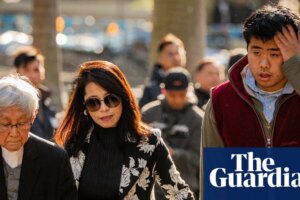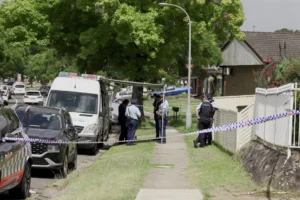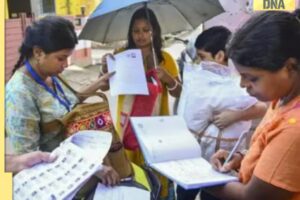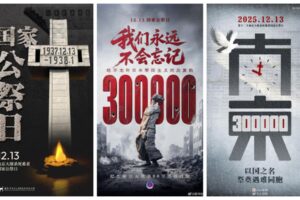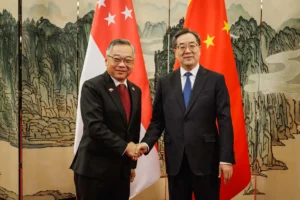
Trump says rare earths issue settled
Trump also said the rare earths issue has been settled and there would be no more roadblocks on them.
Speaking aboard Air Force One, the US president was also reported as saying it was a one-year agreement that would be extended.
Trump also said US tariffs on China would be lowered to 47% from 57%.
He said he would be going to China in April and that Xi would come to the US at some stage after that, in comments carried by Reuters.
He also said Taiwan didn’t come up during the meeting.
Share
Updated at 05.51 CET
Key events
Show key events only
Please turn on JavaScript to use this feature
More now on rare earths: Donald Trump has said his meeting with Xi Jinping removed the “roadblock” on the crucial minerals, yielding a one-year extendable deal on rare earth supplies.
China exercises a virtual monopoly on so-called “rare earth” metals, essential for everything from household appliances to cars, energy and weapons.
“All the rare earths has been settled, and that’s for the world,” Trump was reported as saying after the meeting, adding that the deal was for a year and would be re-negotiated annually.
During his Asia tour, Trump also signed a deal with Japan securing supplies of critical minerals and rare earths.
The US president said:
There’s no roadblock at all on rare earths – that will hopefully disappear from our vocabulary for a little while.
And for a quick brush-up on the crucial minerals – which are critical for defence, auto and electronic industries and have become a flashpoint in international diplomacy and trade – we have this explainer:
Share
Updated at 07.14 CET
Five key takeaways from Trump-Xi meeting
Helen Davidson
Trump has just given a press conference on a very bumpy Air Force One. He’s gone into quite a bit of detail about the meeting’s outcomes, saying it was a 12 out of 10. Trump said the meeting was “amazing”, with “an outstanding group of decisions made”.
“We’ve come to a conclusion on many important points,” he said.
Noting that we do not yet have anything from the Chinese side on their interpretation of events, here are some key takeaways from what Trump has said:
Visits
The US president told reporters he would go to China in April and that Xi “will be coming here some time after that. Whether it’s in Florida, Palm Beach or Washington DC”.
Rare earths
Trump said China has agreed on a one-year deal to supply rare earths, after its shock announcement that it was banning exports if there was any chance of the products having dual use for foreign militaries or some semiconductor sectors. But Trump said Xi said “they’re gonna keep those flowing”. He expected the one-year deal to be extended.
Trump said:
All of the rare earth has been settled. That roadblock is gone now, there’s no roadblock at all on rare earths.
Tariffs
Trump said Xi was going to “work very hard to stop the flow” of precursor chemicals that the US said are being used to make fentanyl. The US had put a 20% tariff on Chinese products specifically to pressure Beijing over fentanyl. Today Trump says he’s reduced it to 10%, lowering the overall tariff burden from 57% to 47%.
Chips
Trump said he and Xi discussed China buying chips from Nvidia, but that US was more of an “arbitrator or referee” between them. When asked if he was going to allow Nvidia’s new Blackwell AI chip to be sold to China, Trump said: “We’re not talking about the Blackwell … But a lot of chips, you know, a lot of the chips. And that’s good for us”.
Ukraine and Taiwan
The war in Ukraine, sparked by Russia’s 2022 invasion, “did come up”, Trump said, saying the US and China are going to work together on it to stop people being killed.
However, he also said:
The two sides are locked in fighting, and sometimes you’ve got to let them fight I guess. Crazy.
Taiwan, which China is threatening to annex militarily, “never came up”, Trump said on Air Force One. “That was not discussed actually.”
Share
Updated at 06.52 CET
One topic that was not discussed in his talks with Xi was Taiwan, Trump said.
Earlier, both leaders ignored a question about the self-governing democracy, amid concern in Taipei that Trump may be willing to make concessions to Xi, who has vowed to “reunify” it with the mainland.
Share
Trump says China to resume buying US soybeans and keep exporting rare earths
Donald Trump has said a deal he struck to reduce tariffs on China involves Beijing in return resuming US soybean purchases, keeping rare earths exports flowing and cracking down on the illicit trade of fentanyl.
Trump also said after his meeting with Xi Jinping that it had been a “great success” and and he would visit China in April for new talks.
The US president repeatedly talked up the prospect of reaching an agreement with Xi since US negotiators on Sunday said they had agreed on a framework with China that would avoid 100% US tariffs on Chinese goods and achieve a deferral of China’s export curbs on rare earths, a sector it dominates.
Chinese stocks climbed to a decade high and the yuan currency to a near one-year peak against the dollar as investors hoped for an easing of trade tensions that have upended supply chains and rocked global business confidence.
Trump told reporters aboard Air Force One about the leaders’ coming visits:
I’ll be going to China in April and he’ll be coming here sometime after that, whether it’s in Florida, Palm Beach or Washington DC.
“A lot of things we brought to finalisation” at Thursday’s talks in Busan, Trump added.
With agencies
Share
Updated at 06.24 CET
Helen Davidson
Continued from last post:
Like today with Nvidia’s AI chips, there were also issues around tech and security. In 2019, US companies were banned from selling products to Chinese tech giant Huawei, on national security grounds. Trump said the issue was “mentioned” but deferred proper discussion about lifting the ban.
Trump and Xi didn’t talk directly about Huawei executive Meng Wanzhou, who was at the time detained in Canada on a US arrest warrant. Two Canadians – Michael Kovrig and Michael Spavor – were simultaneously being detained in China, in what was widely seen as an act of hostage diplomacy. All three were later released in an apparent deal, more than two years later.
There’s not yet been full details of how today’s meeting went, but Chinese state media reported earlier: “During the meeting, Trump said that the US and China have reached many consensus and will reach even more, saying: ‘I believe we will build a long-term, good relationship’.”
Share
Updated at 06.01 CET
Helen Davidson
The last time Xi and Trump met was in June 2019, during Trump’s first term. Looking back at it feels … familiar.
The meeting was in Osaka, on the sidelines of the G20, and just months after trade talks (during the first Trump-China trade war) had broken down. The US had accused China of reneging on trade promises, and Trump raised tariffs from 10% to 20% on about $200bn of Chinese imports. China had hit back with its own tariffs.
Today, a mishmash of overlapping industry and punishment specific tariffs are on average far higher, and the US is threatening 100% tariffs if China doesn’t back down from its ban on some rare earth sales.
But in 2019 the meeting appeared to help, with Trump declaring things to be “right back on track”. He praised Xi as a great leader, and Xi noted there had been disagreements but that it was important the relationship remain strong.
Both sides said they would not impose further tariffs and that the world’s two biggest economies would restart negotiations on a trade deal. He said China would soon be buying “a tremendous amount of food and agricultural product”, again in parallel with today’s meeting as Trump sought to have China restart its US soybean purchases.
Continued next post
Share
Donald Trump also said aboard Air Force One after the meeting that the US and China would “work together” on the Ukraine war.
Share
Trump says rare earths issue settled
Trump also said the rare earths issue has been settled and there would be no more roadblocks on them.
Speaking aboard Air Force One, the US president was also reported as saying it was a one-year agreement that would be extended.
Trump also said US tariffs on China would be lowered to 47% from 57%.
He said he would be going to China in April and that Xi would come to the US at some stage after that, in comments carried by Reuters.
He also said Taiwan didn’t come up during the meeting.
Share
Updated at 05.51 CET
Donald Trump has been reported as saying that his meeting with Xi Jinping today was amazing and it was agreed that the Chinese leader would work very hard to stop fentanyl.
Trump hinted this week he would reduce US tariffs on Chinese goods in exchange for a commitment by Beijing to stem the flow of ingredients needed to make fentanyl, an opioid that is the leading cause of overdose deaths in the US.
We’ll bring you more comments from Trump as they come in.
Share
Updated at 05.41 CET
Away from the Busan talks a lot of attention is also on Donald Trump’s announcement just before the meeting that he has ordered the Pentagon to start nuclear weapons testing at the same level as China and Russia.
It came after Russia’s Vladimir Putin said on Wednesday that Moscow had successfully tested its Poseidon nuclear-powered super torpedo in defiance of US warnings.
As reported earlier, Trump posted on social media less than an hour before meeting Xi that Russia had the second-biggest nuclear arsenal after the US and that China was “a distant third”.
The US president’s post said:
Because of other countries testing programs, I have instructed the Department of War to start testing our Nuclear Weapons on an equal basis. That process will begin immediately.
As our full report on Trump’s threat says, the US last held a full nuclear weapons test in 1992, and China and Russia are not known to have held any such tests since the same era.
Trump’s reference to “on an equal basis” left it unclear what weapons testing could take place, or whether he was referring to displays of power similar to those recently conducted by Russia.
The full report by Abené Clayton and Pjotr Sauer is here:
Share
Updated at 05.29 CET
Donald Trump has been seen getting aboard his presidential aircraft Air Force One, without talking to reporters.
Neither he nor Xi have made any public comment yet on their meeting.
Share
Updated at 05.13 CET
Helen Davidson
Helen Davidson has given us an updated list of who was took part in the talks:
Xi Jinping was flanked by his foreign minister Wang Yi and senior advisor Cai Qi (a high-ranking politburo member who is essentially Xi’s chief of staff). Closest to the cameras is vice-minister of foreign affairs Ma Zhaoxu, then He Lifeng, the vice premier of China. At the far end of the table is the chair of China’s main planning agency, Zheng Shanjie, and Wang Wengtao the minister of commerce.
On the US side, Trump has brought secretary of state Marco Rubio, treasury secretary Scott Bessent, trade representative Jamieson Greer, commerce secretary Howard Lutnick, US ambassador to China David Purdue and the White House chief of staff Susie Wiles.
Share
Trump-Xi meeting ends
We’re seeing live footage of Trump and Xi leaving the negotiations building after shaking hands.
Xi has gotten into a limousine and it is being driven away.
The meeting reportedly lasted one hour and 40 minutes.
Trump and Xi shake hands after their high-stakes meeting in Busan. Photograph: Andrew Caballero-Reynolds/AFP/Getty ImagesShare
Updated at 05.10 CET
Chinese state media is saying the Trump-Xi meeting has finished.
Share
Updated at 04.56 CET
While the two leaders hold their talks, our correspondent in Busan, Justin McCurry, has pieced together what we have seen so far, following their initial greeting and then the opening exchanges once seated with their delegations.
Share
Chinese shares climbed to a decade high as Trump and Xi began their meeting.
Investors appeared heartened by early signs of cooling tensions between the world’s top two economies after recent escalations, while also positioning defensively with a sense of deja vu that the real deal may offer far less to celebrate, Reuters reported.
The benchmark Shanghai Composite Index reversed early losses, rising as much as 0.2% to 4,025.70 in morning trading, reaching its highest since 2015, driven by hopes for de-escalation in the US-China trade dispute.
Banking, insurance and liquor sectors led gains as sentiment remained cautious.
Hong Kong’s Hang Seng Index rose 0.6% after resuming trade following a holiday on Wednesday.
Share
Taiwan’s foreign minister has said it is “confident” in its relations with the US amid the Trump-Xi talks.
Lin Chia-lung – asked by reporters about the meeting and whether Taiwan could come up – said the government was “of course” paying attention to the talks.
Taiwan and the US had close cooperation on security and other matters, he said in Taipei.
“So we have confidence in Taiwan-US relations and have close communication channels,” Lin added, quoted by Reuters.
Taiwan’s democratically elected government rejects Beijing’s claims of sovereignty.
Since taking office this year, Trump has vacillated on his position towards Taiwan while pursuing a trade deal with Beijing. The US president says Xi Jinping has told him he will not invade while Trump is in office, but Trump has yet to approve any new US arms sales to Taipei.
Share
Updated at 04.18 CET
Helen Davidson
Both leaders have brought a high-level entourage with them for the talks.
Xi is flanked by his foreign minister Wang Yi and senior advisor Cai Qi (a high-ranking politburo member who is essentially Xi’s chief of staff). Closest to the cameras is He Lifeng, the vice premier of China. At the far end of the table is the chair of China’s main planning agency, Zheng Shanjie, and vice-minister of foreign affairs Ma Zhaoxu.
On the US side, Trump has brought secretary of state Marco Rubio, treasury secretary Scott Bessent, trade representative Jamieson Greer, commerce secretary Howard Lutnick, US ambassador to China David Purdue and the White House chief of staff Susie Wiles.
The Chinese and US sides at the negotiating table, with Xi and Trump far left and far right. Photograph: Andrew Harnik/Getty ImagesShare
Updated at 03.57 CET
The US will make an announcement that will be a “resounding victory” for its farmers after the Trump-Xi meeting, the US Treasury secretary posted on X on Thursday in the lead-up to the talks.
Scott Bessent said earlier this month he anticipated China would restart substantial buying of US soybeans.
America’s soybean farmers have been stuck in the middle of the trade war between the US and China, the biggest purchaser of American soybean exports, used to feed China’s pigs. Donald Trump’s tariffs prompted the country to exit the soybean market and US midwestern farmers have been waiting on a solution, as you can read in this feature from Rachel Leingang of the Guardian US.
It details how no other country comes close to purchasing as many American soybeans as China – last year, it was more than $12bn worth. This year, the country has not purchased a single dollar’s worth, cutting off the country that makes up about half of US soybean exports.
While Trump has said he intends some sort of payment to go to soybean farmers hurt by tariffs, an announcement of a specific plan is on hold while the government is shut down. He said in a recent Truth Social post that at his Xi meeting “soybeans will be a major topic of discussion”.
Share
Updated at 04.45 CET
